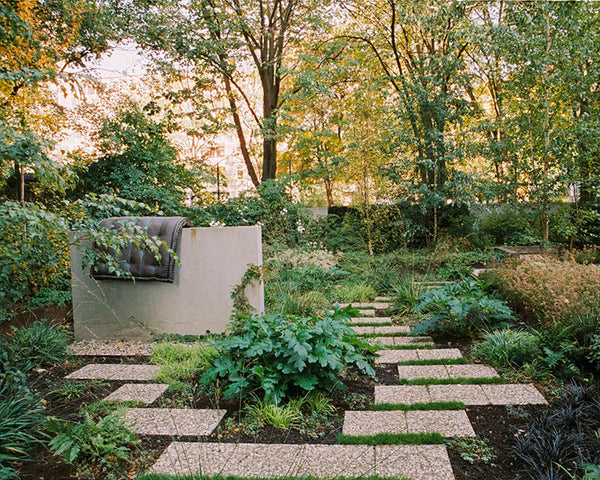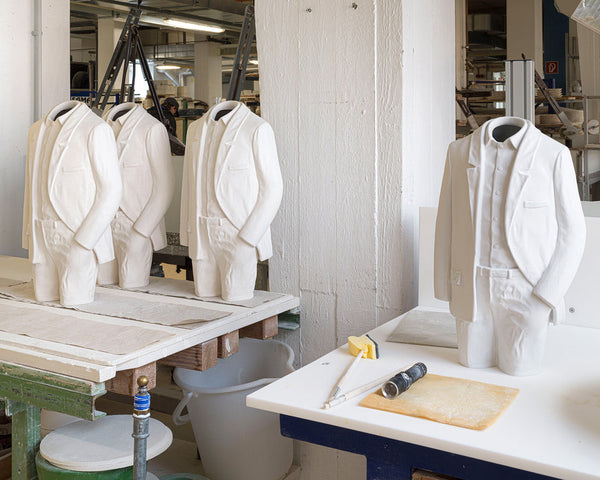
GROUP SHOW
GROTESK
5 APRIL – 3 AUGUST 2025

Portrait by Michael Wurm © Courtesy of the artist
Erwin Wurm (b. 1954 in Bruck an der Mur, Austria) lives and works in Vienna. His oeuvre comprises sculptures, photography, video, performance, and painting. His works often involve everyday objects such as cars, houses, clothing, luxury bags, and food products, with which he ironically comments on consumerism and capitalist mass production. Wurm gained widespread popularity in the 1990s with his “One Minute Sculptures”. Museum pedestals are displayed and left devoid of any work, so that the audience can take the place of the sculpture for one minute, according to the artist’s whimsical instructions. With this ironic yet radical gesture, Wurm democratizes and completely rethinks the classical concept of sculpture, traditionally associated with the weight of the material and its solidity over time.
Wurm plays with volume as a primary sculptural technique. Emblematic of his work are everyday objects and status symbols with exaggerated, bloated volumes, like Fat Car or Fat House, or conversely - shrunk, narrowed, or distorted, as in Narrow House. Wurm often appropriates food items such as pickles, sausages, and bread, which, given their place in Austrian cuisine, become an ironic commentary on identity. For example, his 2008 Self-Portrait as a Pickle was composed of numerous standing pickles, which have subsequently become one of his most recognizable series. Another approach Wurm uses is the transformation of iconic images and status symbols into anthropomorphic characters, such as a Birkin bag with legs, making us unsure whether we carry the bag, or it carries us. Often in his work, Wurm also explores the idea of (second) skin, investigating the tension between the outer form and the volume within. For example, he uses clothing and “dresses up” sculptural and architectural volumes, exploring the contour of the absent body.
“Because he had no other choice, he studied sculpture after all – but only to sabotage this art form,” writes Èlise Mougin-Wurm in her children’s book Erwin Wurm. The Sculptor Who Didn’t Want to Make Sculptures. Indeed, in his many years of practice, Wurm has consistently questioned what sculpture is, expanding our understanding of the medium. He represented his country at the Venice Biennale in 2017, and his work has even gained significance beyond the art world and found its way into pop culture, not least through the Red Hot Chili Peppers’ music video for their song “Can’t Stop,” in which they adopt the idea of the “One Minute Sculptures”.
Erwin Wurm has had solo exhibitions at numerous international institutions including most recently Yorkshire Sculpture Park, UK (2023), Tel Aviv Museum of Art (2023), SCAD Museum, USA (2023), Suwon Museum of Art, Suwon, Korea (2022), Biblioteca Nazionale Marciana, Venice, Italy (2022), Museum of Contemporary Art Belgrade, Serbia (2022), MAK (Museum of Applied Arts), Geymüllerschlössel, Vienna, Austria (2021), Taipei Fine Arts Museum, Taipei City, Taiwan (2020), Musée des Beaux-Arts, Musée Cantini and Centre de la Vieille Charité, Marseille, France (2019) and Kunstmuseum Luzern, Switzerland (2018). At the 54th Venice Biennale in 2011, Wurm showed “Narrow House,” a model of his childhood home, reduced to one-sixth its size along its longitudinal axis at Palazzo Cavalli Franchetti as part of the collaborative event Glasstress. In 2017, he represented Austria at the 57th Venice Biennale. In 2020, on the occasion of Lent, Wurm installed an 80-square-meter Lenten veil in the shape of a purple knitted sweater in Vienna’s St. Stephen’s Cathedral as a symbolic sign of “warming charity.” Wurm’s work is included in the permanent collections of major international institutions, including Tate Modern, London; The Museum of Modern Art, New York; Solomon R. Guggenheim Museum, New York; Centre Pompidou, Paris; Albertina, Vienna; National Museum of Art, Osaka; and MMK Museum für Moderne Kunst, Frankfurt.
In 2024, the Albertina Modern will celebrate Erwin Wurm with an extensive retrospective show on the occasion of his 70th birthday. Further upcoming shows will be held at Fosun Foundation, Shanghai, Bibliotheca Marciana, Venice and Museo Novocento, Florence.
FULL CV
Erwin Wurm (b. 1954 in Bruck an der Mur, Austria) lives and works in Vienna. His oeuvre comprises sculptures, photography, video, performance, and painting. His works often involve everyday objects such as cars, houses, clothing, luxury bags, and food products, with which he ironically comments on consumerism and capitalist mass production. Wurm gained widespread popularity in the 1990s with his “One Minute Sculptures”. Museum pedestals are displayed and left devoid of any work, so that the audience can take the place of the sculpture for one minute, according to the artist’s whimsical instructions. With this ironic yet radical gesture, Wu...
Erwin Wurm (b. 1954 in Bruck an der Mur, Austria) lives and works in Vienna. His oeuvre comprises sculptures, photography, video, performance, and painting. His works often involve everyday objects such as cars, houses, clothing, luxury bags, and food products, with which he ironically comments on consumerism and capitalist mass production. Wurm gained widespread popularity in the 1990s with his “One Minute Sculptures”. Museum pedestals are displayed and left devoid of any work, so that the audience can take the place of the sculpture for one minute, according to the artist’s whimsical instructions. With this ironic yet radical gesture, Wurm democratizes and completely rethinks the classical concept of sculpture, traditionally associated with the weight of the material and its solidity over time.
Wurm plays with volume as a primary sculptural technique. Emblematic of his work are everyday objects and status symbols with exaggerated, bloated volumes, like Fat Car or Fat House, or conversely - shrunk, narrowed, or distorted, as in Narrow House. Wurm often appropriates food items such as pickles, sausages, and bread, which, given their place in Austrian cuisine, become an ironic commentary on identity. For example, his 2008 Self-Portrait as a Pickle was composed of numerous standing pickles, which have subsequently become one of his most recognizable series. Another approach Wurm uses is the transformation of iconic images and status symbols into anthropomorphic characters, such as a Birkin bag with legs, making us unsure whether we carry the bag, or it carries us. Often in his work, Wurm also explores the idea of (second) skin, investigating the tension between the outer form and the volume within. For example, he uses clothing and “dresses up” sculptural and architectural volumes, exploring the contour of the absent body.
“Because he had no other choice, he studied sculpture after all – but only to sabotage this art form,” writes Èlise Mougin-Wurm in her children’s book Erwin Wurm. The Sculptor Who Didn’t Want to Make Sculptures. Indeed, in his many years of practice, Wurm has consistently questioned what sculpture is, expanding our understanding of the medium. He represented his country at the Venice Biennale in 2017, and his work has even gained significance beyond the art world and found its way into pop culture, not least through the Red Hot Chili Peppers’ music video for their song “Can’t Stop,” in which they adopt the idea of the “One Minute Sculptures”.
Erwin Wurm has had solo exhibitions at numerous international institutions including most recently Yorkshire Sculpture Park, UK (2023), Tel Aviv Museum of Art (2023), SCAD Museum, USA (2023), Suwon Museum of Art, Suwon, Korea (2022), Biblioteca Nazionale Marciana, Venice, Italy (2022), Museum of Contemporary Art Belgrade, Serbia (2022), MAK (Museum of Applied Arts), Geymüllerschlössel, Vienna, Austria (2021), Taipei Fine Arts Museum, Taipei City, Taiwan (2020), Musée des Beaux-Arts, Musée Cantini and Centre de la Vieille Charité, Marseille, France (2019) and Kunstmuseum Luzern, Switzerland (2018). At the 54th Venice Biennale in 2011, Wurm showed “Narrow House,” a model of his childhood home, reduced to one-sixth its size along its longitudinal axis at Palazzo Cavalli Franchetti as part of the collaborative event Glasstress. In 2017, he represented Austria at the 57th Venice Biennale. In 2020, on the occasion of Lent, Wurm installed an 80-square-meter Lenten veil in the shape of a purple knitted sweater in Vienna’s St. Stephen’s Cathedral as a symbolic sign of “warming charity.” Wurm’s work is included in the permanent collections of major international institutions, including Tate Modern, London; The Museum of Modern Art, New York; Solomon R. Guggenheim Museum, New York; Centre Pompidou, Paris; Albertina, Vienna; National Museum of Art, Osaka; and MMK Museum für Moderne Kunst, Frankfurt.
In 2024, the Albertina Modern will celebrate Erwin Wurm with an extensive retrospective show on the occasion of his 70th birthday. Further upcoming shows will be held at Fosun Foundation, Shanghai, Bibliotheca Marciana, Venice and Museo Novocento, Florence.
FULL CV


